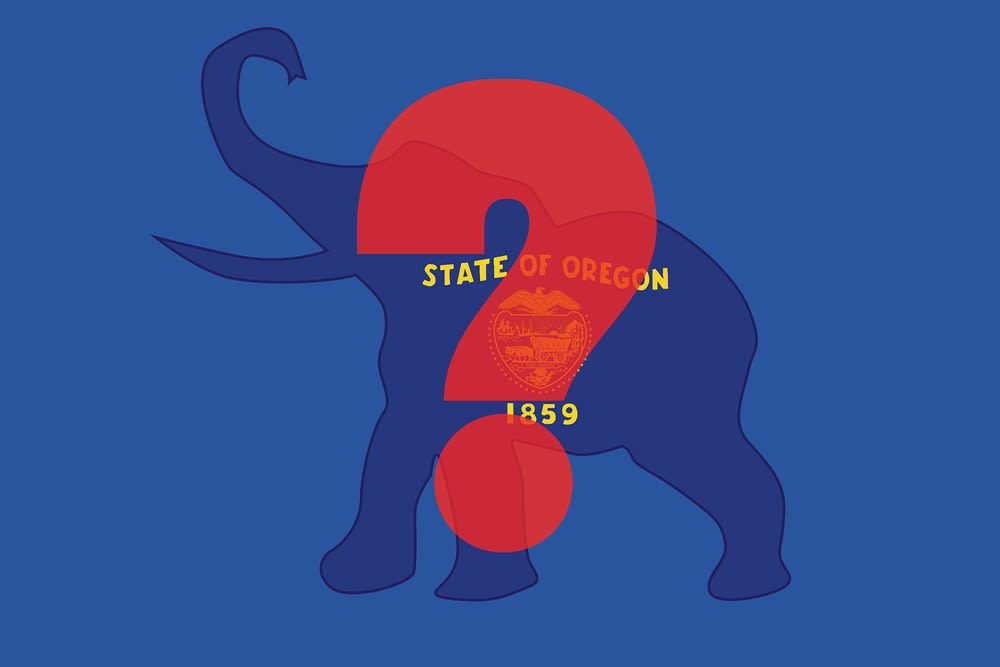Is the Red Wave Finally Coming for Oregon?

Well, well, well, Oregon. What have we here? An actual, honest-to-goodness barnburner of an election?
Yes, there are caveats. Polls can be wrong (just ask Hillary Clinton, or, for that matter, Sarah Iannarone.) The Democratic turnout machine, fueled by public employee unions in the Willamette Valley, should not be underestimated. There’s still plenty of time for an October surprise. (Like, say, a candidate pulling out of a race last minute and directing her supporters elsewhere.) And particularly at the top-of-the-ticket Oregon governor’s race, money continues to pour in like never before, setting the stage for some potent, needle-moving ad messages in the final stretch.
But with just 23 days to go until Election Day, the storyline is solidifying: Reliably-if-never-overwhelmingly blue Oregon is trending reddish.
The best indication that Democratic gubernatorial candidate Tina Kotek is in a jam? The presence of one President Joe Biden, who is heading to Oregon this coming Friday and Saturday to headline a big-ticket fundraiser on her behalf.
Usually, unless there are natural disasters, like wildfires or (please no) earthquakes, Oregon doesn’t get a ton of love from sitting presidents. We’re not the piggybank, like Silicon Valley to our south or Seattle to the north, and our electoral votes are historically firmly enough in the Democratic column that we don’t get much swing state love, unlike, say, Arizona, Nevada, Pennsylvania or Georgia.
This year is different. (And also catnip to national media outlets, in a way we also aren’t used to.) The most obvious reason, of course, is the presence of uber-connected Democrat-turned-Independent Betsy Johnson, a longtime state Senator who is running a well-funded third-party campaign.
Barring the aforementioned October surprise, Johnson has almost no chance of actually winning this race (Politics site FiveThirtyEight pegs her odds at just under 1 percent), but she’s been a magnet for disaffected voters from both mainstream parties. As a recent poll by DHM Research for The Oregonian showed, Johnson is pulling more party voters away from Kotek than she is from Drazan, a big factor in the race’s current dynamic, and part of why Biden’s been dispatched to help shore up her base.
Kotek is also struggling to get her message to resonate with a broader consensus of voters. Like many national Democrats, she’s hitting hard on the threat to reproductive rights after the Supreme Court’s decision in Dobbs v. Jackson Women’s Health Organization. It should be a smart move, given that Oregonians are overwhelmingly pro-choice, but the same DHM poll showed that abortion justice is actually fairly far down the list of priorities on the minds of most voters this year. Top on the list: homelessness and cost of living.
That may be because many of the state’s voters believe that abortion rights aren’t in jeopardy here, given that they are codified into state law. But Republican candidate Christine Drazan has made it clear that she would support “common-sense regulations on abortion,” including “protecting life in the third trimester.”
Another reason that registered Democrats may not feel a huge sense of urgency about supporting Kotek: They think that the Oregon Legislature, in which Democrats presently hold supermajorities in both chambers, would provide a bulwark against any Drazan or Johnson administration. (Whether that would lead to bipartisanship or four years of gridlock remains to be seen.)
But continued Democratic control in the state Legislature, while likely, is not a certainty. A handful of state Senate seats, mostly in swing districts in Marion County, Clackamas County, the Oregon Coast and in the Hood River Valley, are in the toss-up column; there are Oregon House districts in play in the same regions as well.
One key indicator to watching in coming weeks: Will national groups, including the Democratic Governor’s Association and its Republican counterpart, keep shoveling money into this race as they’ve been doing? If so, that’s a good indication that internal polls match external ones—the race is too close to call, and both parties will be looking to spend big to motivate or persuade voters, especially as ballots arrive in the mail.
Meanwhile, Drazan is bringing in her own big gun—and no, it’s not Donald Trump. She’ll be campaigning with Virginia Gov. Glenn Youngkin, a Republican who pulled off a big upset in a blue state, in part by pushing back on pandemic-era restrictions on schools and businesses. That topic was fresher for Youngkin in 2021, but could still hold potency for Drazan this year, particularly given the metro area’s slow recovery.
Don’t overlook upheaval in the state’s Congressional races, too, amid all the focus on the gubernatorial campaigns. Oregon got an extra Congressional seat this year, representing Portland’s southwestern suburbs, wine country to the Coast range, and the Salem area. What’s more, Democratic incumbent Kurt Schrader lost his primary in a newly-redrawn district that now includes a good chunk of Central Oregon and longtime Democratic Rep. Peter DeFazio is retiring, creating an open seat in Eugene.
FiveThirtyEight’s polling aggregates rate the race for Schrader’s seat as a true toss-up, the contest for the new sixth district as leaning towards the Democrats and the fourth district as a “likely Democratic” seat, but history—and increasingly aggressive fundraising to fuel last minute ad pushes in all three seats—suggests a cloudier picture. Generally, in a midterm election, the president’s party loses seats. Oregon has dodged so-called red waves in past, but all tides do eventually turn.




